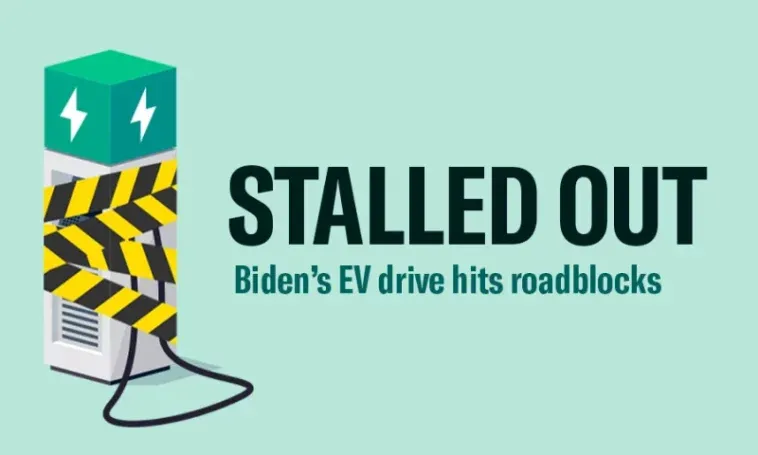(Washington Examiner) Many drivers remain not sold on switching their gas-powered vehicles for electric vehiclesbecause they fear the cars won’t be reliable, they lack access to charging infrastructure, or they have so-called “range anxiety.”
Washington , D.C., resident Kayla Maurer drives a hybrid vehicle to her workplace in Silver Spring. And while she said she is open to the idea of purchasing an EV at some point, she said a lack of charging access at home poses a challenge, at least for now.
“Thinking about where and how long it’d take me to charge my vehicle every day would be difficult,” she said in an interview.
Road trips or other travel with friends might also prove more difficult, at least until more charging infrastructure is built out. “I would love to make the switch at some point,” she said.
Such hurdles stretch far beyond the Washington area and pose a problem for the Biden administration’s goal of ensuring that 50% of new cars sold are EVs by 2030. Achieving this sales target requires reaching drivers who live in rural areas, with fewer public chargers, or urban areas, where off-street parking is scarce.
The administration is pushing EV adoption with rules on gas cars and subsidies for EVs. Under the Inflation Reduction Act, consumers can receive up to $7,500 in tax credits designed to help offset high upfront EV costs.
The administration is aware the country is not ready to switch to EVs and would need much more infrastructure — it has poured billions into such networks. The Bipartisan Infrastructure Law allocated $7.5 billion in funds to develop a so-called national EV charging corridor, with the aim of building out 500,000 high-speed charging stations across 75,000 highway and interstate miles across the United States.
Automakers have also poured millions into the effort, partnering with EV charging companies to build out networks and help accelerate the EV transition.
Still, it is a daunting goal, and a lot is at stake. Some would-be EV buyers are hesitant because of fears related to reliability, range anxiety, and public charging infrastructure.
Personal and public EV chargers can break down and require repair. For personal chargers, the fixes can be complicated and time-consuming.
Reporting an outage at a public charging station can also be difficult — as can accessing up-to-date information about where to find reliable chargers.
Public charging reliability has not yet been studied on a national scale, though some of the most comprehensive reports to date have not inspired confidence.
For instance, researchers at the University of California, Berkeley, conducted a field study to test every public “fast charger” in the San Francisco Bay Area. Of the 181 chargers, they found that less than 73% were functional. Problems included unresponsive or unavailable screens, network or payment system failures, or broken connectors. In other cases, the charger cables were simply too short to reach the EVs. Eight days later, they went back to the same stations and did not observe a change in functionality.
Their findings appear to contradict statements from EV service providers in the area, which reported uptime of between 95% and 98%.
That’s a big deal — because to be eligible for federal funding under the National Electric Vehicle Infrastructure, or NEVI , program, these “fast charging” station operators must be able to demonstrate 97% uptime.
But how the government will monitor or enforce this standard is unclear. There is no standard definition or calculation methodology for determining “uptime” for electric vehicle service equipment, or EVSE, as the California researchers pointed out.
A September 2022 user experience study for EV drivers conducted by JD Power echoed these frustrations about the reliability of public chargers. According to that study, 1 out of every 5 respondents was unable to charge their EVs due to a malfunctioning or out-of-service charging station.
“Not only is the availability of public charging still an obstacle, but EV owners continue to be faced with charging station equipment that is inoperable,” Brent Gruber, the director of global automotive at JD Power, said in a statement.
Access to charging infrastructure
The U.S. saw 282,000 EV sales in the fourth quarter of 2022, a 51% jump compared to the same period in 2021, according to a new report from the Alliance for Automotive Innovation.
But public chargers have not been added at the same speed. To date, the U.S. has more than 3 million EVs on the road, and roughly 103,000 publicly available EV chargers, according to the Biden administration’s most recent estimate — amounting to around one public charger for every 29 EVs.
That’s well below the estimated need from the California Energy Commission, which recommends a 7:1 ratio of EVs to public and shared private chargers. (No state currently satisfies that threshold.)
The U.S. would need to add 330,000 public chargers to satisfy that number today, and it would need to continue to do so at a rapid clip as EV sales continue to rise.
Most drivers are also relatively unfamiliar with the EV landscape. There’s a real educational gap between owning and refilling a traditional gas-powered vehicle versus owning an EV and understanding the charging technology and infrastructure, industry experts say.
Public chargers can be intimidating since there is no “one size fits all” model for EVs — that is to say, not all public EV chargers work on all electric vehicles, nor do all chargers give off the same amounts of power to all EVs.
But for the most part, that level of understanding is still largely limited to EV owners.
“Most people today are just [operating based on] what they know, which is driving a gas-powered vehicle,” said Matt Teske, the founder and CEO of ChargeWay, an app that helps connect EV drivers with local charging stations.
“When you have a conversation about electric vehicles with an average consumer who hasn’t done their homework … they might make assumptions that if they buy any electric car, they assume they can go to any EV charging station. And that’s not true, based on the fact that there are different plug types,” he said in an interview.
“No. 2 is if they’re told by an automaker that their EV can fast-charge from 10% to 80% in 30 minutes, then the first thing they’re gonna think is, well, that means that it always charges that fast. And the answer is, well, no, that’s the best-case scenario,” he added.
Most new EV drivers with private chargers are also surprised to find the vast majority of their fill-ups, between 90% and 95%, are slow fill-ups, designed to reduce the strain on power grids.
“Charging, and using electricity as fuel, is very unique based on drivers’ use case,” Teske said.
Geographic constraints
Geographic constraints are another limiting factor. A total of 30% of all public charging infrastructure in the U.S. is located in California, according to the Alliance for Automotive Innovation.






